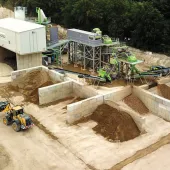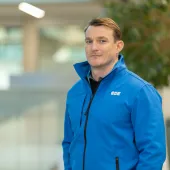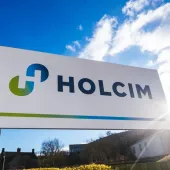EQAR Award for CDE Global

First published in the October 2015 issue of Quarry Management
Advances in construction and demolition waste recycling technology recognized by European Quality Association for Recycling
Earlier this year [2015] CDE Global received an award for innovations in the recycling of construction, demolition and excavation waste at the European Quality Association for Recycling (EQAR) annual conference in Rotterdam. The award was presented in recognition of various product innovations launched by the company and first introduced on a project in Stuttgart, Germany, for Feess Erdbau GmbH.
Commenting on the award, Eoin Heron, CDE’s regional manager for Europe and Russia, said: ‘The project we have completed with Feess Erdbau in Stuttgart is the culmination of more than a decade of experience in the design and delivery of recycling plants for construction and demolition (C&D) waste. Our initial project portfolio has been built in the UK market and this has expanded into Europe in recent years, with great success.’
The Stuttgart project saw the launch of the R2500 primary screening unit as the feed system for C&D waste recycling plants. ‘We developed the R2500 specifically for use on projects where difficult materials are being processed,’ explained CDE product development manager, Kevin Vallelly. ‘The machine allows for the efficient delivery of C&D waste material to the washing plant as a result of its large-capacity feed hopper which can accommodate up to 20 tonnes of material. This ensures that the plant operator can charge fill the plant and is also free to complete other work on site, which eliminates the requirement for a dedicated person to feed the recycling plant.’
The R2500 removes any +100mm material from the feed and this is discharged via an oversize stockpile conveyor. Meanwhile, the –100mm material is delivered to an M2500 mobile washing plant. The most significant development of the M2500 was the introduction of the new Infinity P2-75 bolted screen – a 5.0m x 1.5m (16ft x 5ft) aggregate screen which has been awarded a global patent based on the construction of the sidewalls of the screen.
‘Going back to day one of the design process, we took our lead from the aerospace industry and how aircraft wings are designed. The only assumptions we made from a design perspective were that the screen was to be rectangular and had to have one, two or three screening decks,’ said Neil Mullan, senior research and development engineer and product specialist for the CDE screening range.
According to CDE, the screens in the Infinity range are able to generate the same acceleration as conventional screens but with less weight, which results in a reduction in power consumption and operational costs. ‘The focus on reducing power consumption is evident in several of the design innovations within the Infinity range and is achieved in balance with using power efficiently,’ explained Mr Mullan.
Ferrous metals are also removed at this stage of the process through the deployment of an overband magnet on the M2500 feed conveyor, with the metals stockpiled in a skip.
The top deck of the Infinity P2-75 screen removes the +45mm material while the 8-45mm material progresses to the scrubbing phase. This involves an AggMax portable log-washer which subjects the material to extreme attrition in order to liberate the recycled aggregate material and effectively remove the fine silts and clays from the waste feed. It is here that lightweights and other contaminants are also removed, including organics, wood, plastics, paper and polystyrene. After passing through the AggMax the recycled washed aggregates are sized into 8–16mm, 16–32mm and 32–45mm products.
The 0–8mm material is pumped from the M2500 sump to an integrated EvoWash sand washing plant where a 0–2mm sand and 2–8mm grit are dewatered and stockpiled into product bays ready for market. The EvoWash removes all the unwanted
–63 micron material and this, along with the waste water from the plant, is delivered to an AquaCell thickener.
The AquaCell is the latest development of the AquCycle range and has been specifically designed for sites where space is restricted. ‘The AquaCycle is tried and tested water-recycling technology but we developed the AquaCell for this project for two main reasons,’ explained Kevin Vallelly. ‘The first is to ensure that operators with severe space restrictions are still able to avail of the opportunity that these washing plants offer. Secondly, as the AquaCell is designed to fit within the footprint of two standard 40ft shipping containers, it makes transport a lot easier.’
Another new feature of the AquaCell thickener is its built-in sludge concentrator, which ensures the delivery of a consistent sludge density to the sludge-management stage. ‘This consistent feed to the decanter centrifuge ensures optimized performance at this stage of processing,’ said Mr Vallelly. ‘We are able to maximize the performance of the sludge-management stage while also ensuring that the production capacity of the washing plant can be maintained, which ensures that production volumes are maintained and our customers can continue to meet the increased demand for their washed recycled sand and aggregates.’
According to Marc Jennings, CDE’s programme manager for this project, the overall objectives of the project – to maximize material recovery, reduce waste volumes and, ultimately, increase the value of recycled sand and aggregates – have all been achieved. ‘The innovations we have introduced to our C&D waste-recycling systems will allow operators to increase the value of recycled sand and aggregates from C&D waste and also expand the range of applications for the final washed products,’ he said. ‘This will further improve the return on investment for these advanced processing systems as the potential for these products to provide a sustainable alternative to virgin material becomes fully apparent.’
For more information visit: www.cdeglobal.com
- Subscribe to Quarry Management, the monthly journal for the mineral products industry, to read articles before they appear on Agg-Net.com








